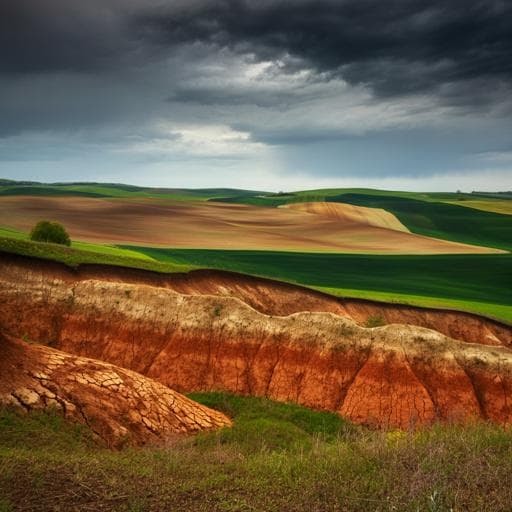
Earth Sciences
Climate and land use changes explain variation in the A horizon and soil thickness in the United States
Y. Zhang, A. E. Hartemink, et al.
This study by Yakun Zhang and colleagues unveils crucial insights into the spatio-temporal dynamics of soil thickness across the conterminous United States from 1950 to 2018. Discover how climate influences soil distributions while land use and erosion shape changes over time, highlighting the regions most affected and in need of conservation.
~3 min • Beginner • English
Introduction
Soil thickness, particularly the biologically active, organic-rich A horizon, underpins plant productivity, carbon storage, hydrological and biogeochemical processes. Solum thickness reflects the balance between soil production (weathering, additions) and losses (erosion), controlled by soil-forming factors (parent material, climate, topography, vegetation) and processes such as water, wind, and tillage. Despite its importance, spatial prediction of soil thickness is challenging due to high small-scale variability and measurement difficulty, and national-scale temporal assessments have been lacking. Earth system models often assume constant soil depth, failing to capture real-world variability. Previous efforts used mechanistic models (soil production and sediment transport under steady-state assumptions) and empirical/statistical models to map soil and horizon thickness, each with limitations for decadal-scale changes. Human activities and climate change have accelerated soil loss, often far exceeding formation rates, with notable A horizon losses in US croplands. This study compiles a large in-situ dataset across the conterminous US from 1950–2018 to quantify spatial and temporal variations in A horizon and solum thickness. Objectives: (1) quantify spatial distributions and effects of soil-forming factors at national and regional (land resource region) scales; (2) investigate temporal variations using selected chronosequences and identify drivers. Hypotheses: (1) national-scale spatial variations are mainly controlled by natural soil-forming factors, with climate exerting the strongest influence (especially in arid and hot regions), followed by topography and land cover; (2) temporal variations are mainly driven by human activities (e.g., land cover/use change, tillage).
Literature Review
Prior work addressing soil thickness includes mechanistic models assuming long-term equilibrium between soil production and erosion via production functions and sediment transport models; however, steady-state conditions are rarely met, and decadal-scale changes are small relative to total regolith depth, limiting applicability. Empirical and machine learning approaches have mapped soil and horizon thickness from local to global scales, but predictions are hampered by high short-distance variability and limited measurements. Reported soil formation rates are typically on the order of a few cm per millennium, while erosion on agricultural lands can be an order of magnitude higher, leading to significant A horizon loss (e.g., one-third of cultivated soils in the US Corn Belt lacking A horizons; croplands reduced 4–69 cm compared to prairies). Parent material strongly influences soil depth (e.g., carbonate vs mafic; age of glacial deposits), and land use affects A horizon thickness via vegetation inputs, erosion, and tillage mixing. Conservation practices can reduce erosion, yet climate-change-driven precipitation changes may increase erosivity in some regions. These studies motivate a comprehensive, data-driven national assessment across eco-climatic zones and over decades.
Methodology
Data: The study used the USDA-NRCS National Cooperative Soil Survey (NCSS) Soil Characterization Database (pedons sampled since the 1900s). Pedons were excavated to 200 cm or bedrock, with field horizon descriptions and lab analyses. Inclusion criteria restricted to CONUS pedons sampled 1950–2018 with valid coordinates, complete horizon designations (excluding reporting layers, D, vesicular, limnic horizons, bisequences), and without missing/discontinuous horizons for topsoil determination or fixed-depth-only profiles. Pedons on human-transported materials and those in types with <10 pedons (e.g., Gelisols) were removed, as were pedons mapped as water, mining, or mechanically disturbed (1938–2018 land use). Outliers with A horizon thickness >100 cm or solum thickness >300 cm were excluded. Final dataset: 37,712 A horizon thickness measurements and 22,409 solum thickness measurements (1950–2018). Mean A horizon thickness = 21 cm; mean solum thickness = 92 cm. Soil orders included: Alfisols, Andisols, Aridisols, Entisols, Histosols, Inceptisols, Mollisols, Spodosols, Ultisols, Vertisols. Environmental variables: Soil temperature and moisture regimes (USDA-NRCS): temperature classes (cryic, frigid, hyperthermic, isomesic, mesic, thermic); moisture classes (aquic, aridic, udic, ustic, xeric). Climate (TerraClimate, 4.6 km, 1958–2018): pr, tmmn, tmmx, pdsi, vpd, vs, ro, sm, aet, pet, def, srad, swe; annual aggregates averaged over 1958–2018 (high correlations with alternative moving-window averages >0.98). Land use (USGS historical mosaics 1938–1992 and LandCarbon 1992–2100; 250 m): eight constant land-use classes (developed, barren, cropland, forest, grassland, pasture, shrubland, wetland) or categorized land-use changes (convert to grassland/shrubland, cropping, grazing, reforestation, urbanization, others). Topography from USGS 3DEP DEM (10 m): elevation, slope, aspect, profile curvature, plane curvature. Parent material from CSP ERGO (90 m): aggregated to 14 classes including alkaline intrusive, alluvium/coastal sediment, carbonate, colluvial, eolian, glacial lake, glacial outwash, glacial till, hydric, non-carbonate, saline lake sediment, silicic residual, volcanic. Spatial analysis: Zonal means computed per 1° longitude (125°W to 67°W) and latitude (25°N to 49°N) for thickness and environmental variables; Pearson correlations between zonal means. Modeling: Generalized additive models (GAMs) were used due to nonlinearity and interpretability, and they outperformed ordinary linear models, LASSO, and Ridge on held-out test data. Final national GAM specification used a spatial smooth term s(X,Y) with thin plate spline (basis size k=800), categorical predictors (soil order, temperature regime, moisture regime, parent material, land use), and a smooth for slope s(slope). Thickness values were log-transformed. Model form: log(thickness) ~ s(X,Y,k=800) + Order + Temperature.regime + Moisture.regime + Parent.material + Land.use + s(slope). Data split: 70% training (n=26,398 A; n=15,686 solum) and 30% testing (n=11,314 A; n=6,723 solum). Performance metrics reported: R², Lin’s concordance (pc), ME, RMSE (on log and original scales). Regional models: GAMs fit per Land Resource Region (LRR; 20 regions in CONUS) with reduced spatial basis (k=100–400) and removal of slope if non-significant. Temporal analysis: Because repeated measures at identical locations were scarce, temporal trends were inferred using chronosequences constructed within LRRs controlling for soil order, temperature regime, moisture regime, parent material, land use, and similar topography (within 250 m elevation and 7.5° slope of subgroup medians; aspects split into north- vs south-facing). Subsets required ≥50 samples and at least one sample per decade. Selected chronosequences: 49 for A horizon across 9 LRRs (sample sizes 51–579), and 9 for solum across 2 LRRs (51–219). To address uneven temporal sampling, for each chronosequence, one sample per decade was randomly drawn with replacement and repeated 100 times; a simple linear regression of thickness vs time was fit for each resample; the median slope (cm/yr) and 5th–95th percentiles provided change rates and confidence bounds. Climate and land-use change summaries were compiled by region to contextualize temporal trends.
Key Findings
- Spatial patterns: A horizon shallowest in western deserts and Rocky Mountains, and along Great Lakes/Appalachians; deeper along Mississippi River Basin and West Coast. Solum shallowest in southwest deserts and Nebraska Sandhills; deeper in the southeast along the Gulf of Mexico. Strong longitudinal patterns for both layers; along latitude, A horizon thicker northward while solum shows a slight increase then continuous decrease toward the north. - Relationship between A and solum thickness: Weak overall correlation (r=0.16). By soil order, deeper Mollisols, Entisols, Inceptisols tend to have thicker A horizons; in Aridisols, Spodosols, Ultisols, A horizons are shallow regardless of solum depth. - Environmental controls (zonal means): Along longitude, A horizon thickness correlates with moisture variables (pr, ro, sm; r=0.47–0.49), not with temperature; solum thickness correlates strongly with temperature (tmmn, tmmx, aet; r=0.63–0.74). Elevation negatively correlated with thickness (r=−0.54 to −0.36). Along latitude, A horizon thickness negatively correlated with temperature (r=−0.38 to −0.37) and moisture deficits (vpd, def, pet, srad; r=−0.44 to −0.32), while solum thickness positively correlated with temperature (r=0.41–0.49) and moisture deficits (r=0.45–0.56), and negatively with elevation (r=−0.42). Profile curvature negatively affected A horizon thickness along latitude (r=−0.26; convex thinner, concave thicker). - GAM results (national): Thickness decreased exponentially with slope up to ~30°. Soil order effects: young soils (Entisols, Inceptisols) have shallower solum; highly weathered Ultisols deeper solum. Mollisols have thickest A horizons; shallow A in Spodosols, Aridisols, Ultisols. Temperature regime: solum deepest in hot regions (hyperthermic, isomesic); A horizon thickest in moderate temperatures (isomesic). Moisture regime: both A horizon and solum significantly thinner in aridic/xeric regions. Parent materials: alluvium/coastal sediments (coasts, Mississippi Basin), eolian (central), and glacial sediments (lake, outwash, till in Midwest/Great Lakes/Northeast) associate with thicker soils. Land use: A horizon thickness varies more by land use than solum; A thicker under cropland, pasture, developed, wetland, and grassland than under barren, forest, shrubland; barren, grassland, shrubland, wetland have shallow soils overall. - GAM results (regional): Slope effects strongest in eastern Udic regions. At regional scales, soil order, parent material, and land use dominate over climate; land use strongly affects A horizon; parent material strongly affects solum. Some covariate effects differ by region (e.g., Histosols depth contrasts between regions; glacial outwash effects vary). - Temporal trends (chronosequences): Largest A horizon loss in Mollisols under cropland in region H (Central Great Plains) with mean −0.44 cm/yr. Forested Alfisols on steep slopes (13°) in region C (California) lost −0.26 cm/yr; Inceptisols in region R (Northeast) lost −0.20 cm/yr. Region M (Midwest) showed widespread A horizon decline averaging −0.12 cm/yr. Across Alfisols, cropland had greater A horizon loss (−0.35 cm/yr) than other land uses. Within Mollisols, A horizons thicker when formed in alluvium/coastal and glacial lake sediments (41 cm and 38 cm) than in eolian and glacial till (35 cm), yet highest A horizon loss occurred for Mollisols in glacial lake sediment (−0.66 cm/yr) and in glacial till under cropping (−0.45 cm/yr). Some regions (e.g., N, Appalachian Mountains) under forest/pasture showed increases in A horizon thickness. For solum, Alfisols under forest in region K (Northern Lake States) lost −1.05 cm/yr; in region M, Alfisols under cropland lost more solum than under forest or pasture. - Contextual changes: Land-use conversion affected ~16% of CONUS (1950–2018), with cropping/grazing expansions mainly in Midwest, Mississippi River, East Coast, Great Plains; reforestation in eastern regions; urbanization in California, Southwest, Northern Atlantic, Florida. Soil moisture increased significantly in several eastern/midwestern regions; temperature increased 0.02–0.03 °C/yr across CONUS. Adoption of conservation tillage rose from ~25% (1985) to ~50% (2018), coinciding with reductions in national soil erosion (from 3.4 billion tons in 1982 to 2 billion tons in the 1990s). - Dataset scope: A horizon n=37,712; solum n=22,409; mean A=21 cm; mean solum=92 cm.
Discussion
Findings support the hypotheses that climate primarily governs spatial distributions of soil thickness at national scales and that human activities and erosion drive temporal changes. Mechanistically, moisture availability promotes A horizon formation and thickening through vegetation productivity and organic matter inputs, whereas temperature accelerates pedogenesis and deepening of the solum; very low temperatures limit development and organic inputs, while higher temperatures increase organic matter decomposition, explaining why A horizons are thickest in moderate temperature regions but solum deepens with temperature. Topography modulates both climate and hydrologic redistribution: high-elevation western regions align with cooler, drier conditions and thinner soils; convex slopes are eroding and thinner, concave positions are depositional and thicker. Parent material exerts strong regional influence on solum depth via mineralogy, texture, and deposit age, with glacial and alluvial materials often associated with thicker profiles. Land use affects A horizon thickness more than solum: cropland often shows thicker A horizons due to tillage mixing and higher inputs (fertilizer, irrigation) but also experiences enhanced erosion, leading to net A horizon losses over time in many agricultural regions. Temporal analyses indicate substantial A horizon degradation in croplands (especially Mollisols of the Central Great Plains and Midwest) and on steep forested slopes, while forests and pastures in some regions gained A horizon thickness, possibly through organic matter accumulation and reduced disturbance. Conservation practices appear to mitigate erosion despite climate-driven increases in rainfall erosivity in certain areas. Overall, the results clarify how climate, topography, parent material, and land use interplay to shape spatial patterns, while land-use change and erosion dominate recent temporal trends.
Conclusion
Climatic variables regulate soil thickness at national scales, with moisture linked to A horizon formation and temperature to solum development. Elevation and climate shape longitudinal patterns, while parent material is a key local to regional control. A horizon thickness is more sensitive to land use than solum thickness. Temporal variations across land resource regions are largely attributable to land use changes and erosion, with severe A horizon losses in Mollisols of the Central Great Plains, Alfisols on steep slopes, and croplands in the Midwest, whereas forests and pastures often show gains. The study compiles and analyzes an unprecedented, long-term, national-scale dataset, leveraging GAMs and controlled chronosequences to disentangle drivers of spatial and temporal variability. Future work should target finer-scale regional analyses linking specific land-use changes and management practices to soil thickness dynamics and explore relationships between soil thickness and other soil properties (e.g., organic matter, bulk density, structure).
Limitations
- Explanatory power: Only about 30–40% of the variation in A horizon and solum thickness at the CONUS scale is explained by spatial terms and environmental drivers; unmodeled local-scale variability likely accounts for much of the remainder. - Temporal scope: Temporal analysis starts in 1950, after widespread adoption of conservation practices, potentially underestimating earlier declines in soil thickness under conventional agriculture. - Sampling unevenness: Uneven observations per year and shifting geographic focus over time (e.g., more cropland samples earlier, more forest samples later) may introduce randomness into spatial-temporal assessments. - Process attribution: The study assumes soil thickness changes arise from erosion or formation, potentially overlooking tillage effects; deep tillage can deepen Ap horizons by mixing, whereas conservation agriculture may reduce erosion without deepening. Changes in soil organic matter and associated porosity/bulk density/structure were not modeled but can affect thickness. - Horizon scope: O horizon thickness, important for carbon sequestration, was not analyzed in detail.
Related Publications
Explore these studies to deepen your understanding of the subject.







